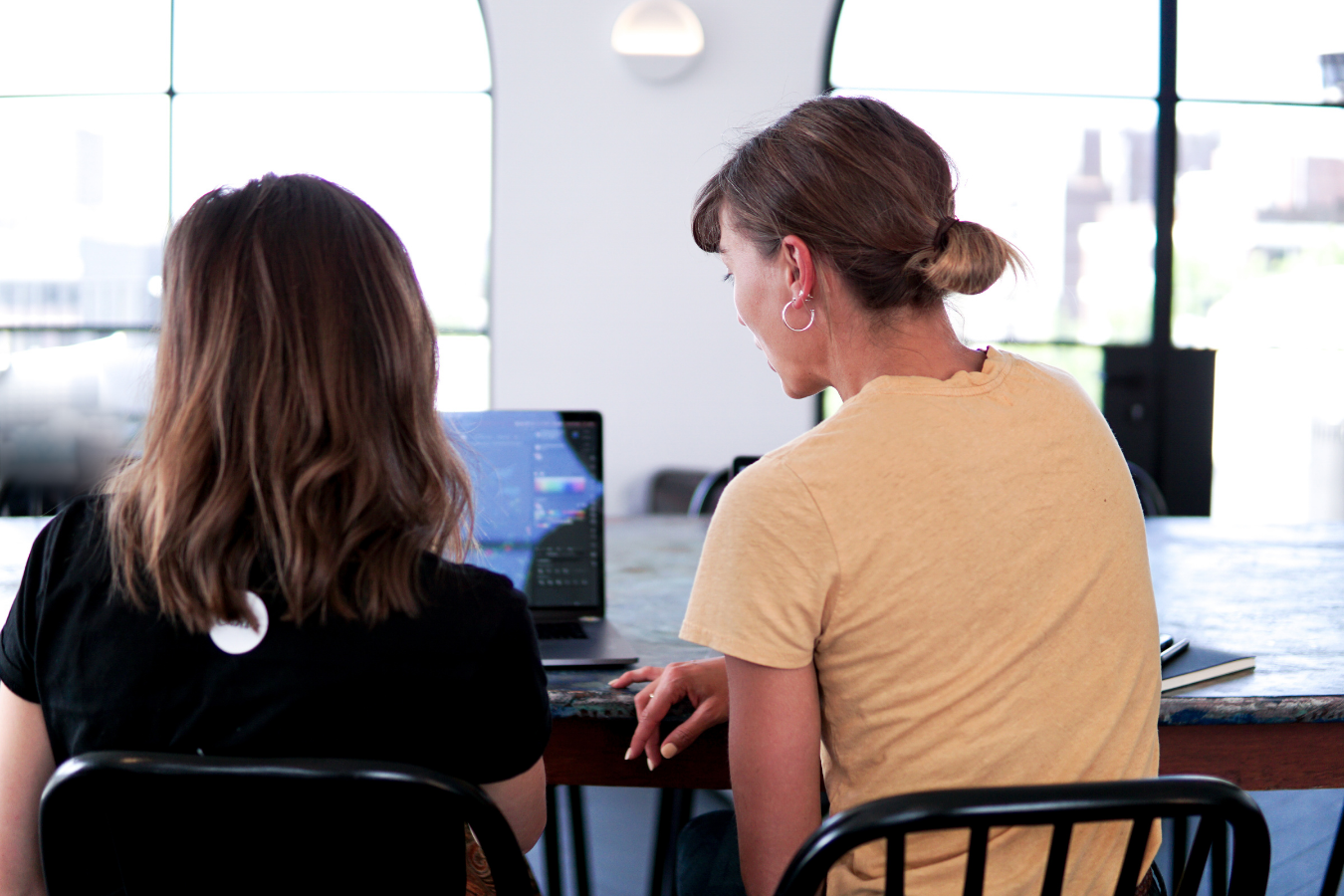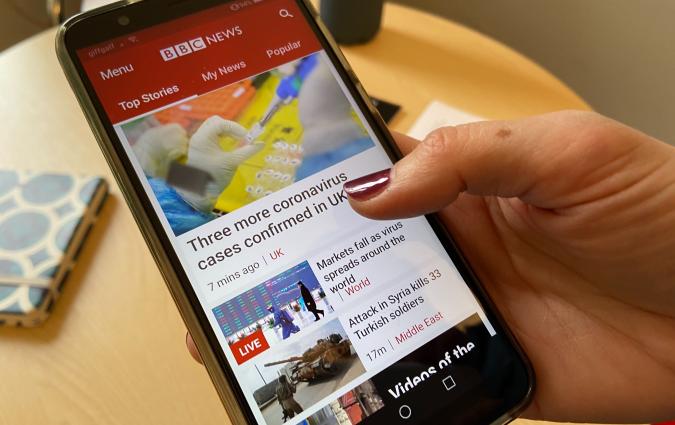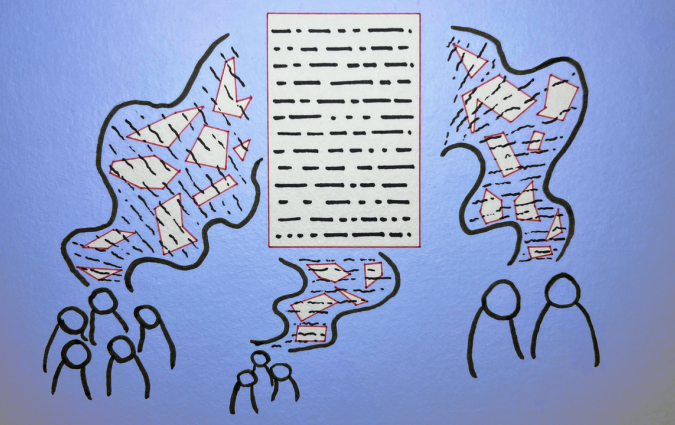Our podcast: How to use metrics to know your audience and sell subscriptions

Image: Canva Studio
The topic
In this podcast we look at how one of the world's leading newsrooms uses data to inform various steps of the newsmaking process, to engage with audiences and drive subscriptions.
Our speakers
Guest: Sophie Ho is the News Analytics Assignment Editor at the Washington Post
Host: Federica Cherubini is the Head of Leadership Development at the Reuters Institute
The podcast
On Spotify | On Apple | On Google
The transcript
A bridge between journalists and analytics↑
Federica: For disclosure for our listener before we get started, I was an Audience Editor myself in my previous role before joining the institute, so I hope you’ll forgive me for saying that I’m very excited to be having this conversation with Sophie today. But Sophie, let’s start from the basics. Explain to us what does it mean to be a News Analytics Assignment Editor.
Sophie: Yeah, happy to walk through this. So I’m the News Analytics Assignment Editor at the Washington Post. This is a role that I moved into in the past few months. Before that, I was a News Audience Analyst on the audience team.
So broadly, my job is split between two different missions. I act as a primary bridge between the newsroom and the company-wide analytics team, and so a lot of that relationship is elevating the priorities of the newsroom to the analytics team and making sure that we’re all on the same page in terms of how we measure success and how we build frameworks to track our biggest initiatives, storylines and coverage areas.
The other part of my role is to act as a coach and a trainer to reporters and editors across the newsroom, and teach them how they can use analytics and metrics in their day to day jobs to inform editorial decisions as well as to inform strategy.
One large part of my job is to craft the vision for which metrics matter, and why, as well as building the tools and the training to support our journalists at all levels.
Federica: Can you tell us more about how does the audience team work with the broader newsroom on a day to day basis?
Sophie: Yeah, happy to talk through that. So as part of my job, I work within the larger audience department. The audience department at the Post covers a lot of different roles. We have our traditional core social programming team, newsletters, and engagement team that focuses on bringing our readers as close to the journalism as possible.
And so I work as part of the general department, and support the teams that are working closely with editors and sections, and really, on a day to day basis, that can look like a lot of different things.
One day I might be working really closely with an editor to go deep into their coverage area, see what has succeeded for them, see what they are curious and want to work on for the future. On another day I might be working with some senior editors to focus on an initiative that spans multiple departments, so it really varies.
I think there’s a lot of context switching that has to happen between the audience team and working with the rest of the newsroom, in terms of working at very high levels with senior editors, all the way down to working with reporters who are really focussed on their specific beat or coverage area.
Federica: And you are a journalist, you joined the Post as Engagement Editor, but you also work, as you mentioned, closely with technology, and you helped create several of the internal tools, data tools that you use. I wonder if many, when thinking about data analytics, imagine the job to be quite a technical one. What are the skills that an audience editor needs to have?
Sophie: That’s a great question. I think it really depends on what type of newsroom the audience team is part of. In my job, there is a level of technical knowledge that I have to have, just in terms of being able to engage in high level conversations with analytics teams, or engineers.
So I did not start in Audience with a technical background. I came from newspapers, from radio stations, from new media initiatives, and so jumping into the Post was kind of my first experience having a more technical-facing role.
I think one of the key skills for any audience editor, especially one that focuses more within data, metrics or analytics, is the ability to context switch and translate large data sets into insights, and I think that skill is really something that’s built up over time.
In my role, I had to really learn more technical knowledge, and I learned that from acting as a student, and recognising what I didn’t know and reaching out to mentors outside of the newsroom to guide my way, and collaborate with me, and train me on how I could talk about analytics and data in the same language that editors use, and also in the same language that the analysts and engineers use across the newsroom.
So I think being able to context switch is really important, and having just a basic understanding of how different teams work and prioritise their values is also very crucial to my job. So much of what I have to do is provide context to other teams on what the priorities are for the newsroom. On the other side, I provide to the newsroom what the priorities of the analytics team is.
And so when you’re in those types of bridge roles, being able to navigate many different personalities, many different structures of teams, and trying to understand what is the actual key, crucial pieces of information every side needs to know in order for us to move forward as one business, if that makes sense.
Federica: Yeah, totally. And actually following up on that, I think it would be fair to say that there has been some scepticism, at least a bit in the past, in the industry about the use of data in guiding editorial decision, so audience editors often make a distinction between being data-led and being data-informed, and to explain it to our audience that means letting the data dictate in a decision, versus using the data to support the decisions that are made following several criteria, amongst which, of course, the editorial sense. What are some of the ways you’ve found most useful in getting journalists to get more comfortable with the idea of using data to inform editorial decisions?
Sophie: That is a great question. So whenever I am talking with a reporter or an editor, a senior editor, whoever it is in the newsroom about analytics, my role, for the first time I always frame it with a general philosophy of, metrics are an important guide to informing our strategy, but it’s not the only guide we look at. I think we are in a great place at the Post, in where we recognise that data can inform our decisions at every level, but we’re not in a place where we’d necessarily make a decision solely based on our metrics.
And so making that distinction very clear, I think, to your point that we are data-informed rather than data-driven, is one of the ways that I try to break down that initial barrier or initial discomfort when it comes to looking at analytics and metrics.
I try to frame using data, looking at analytics over time, as something that can help empower ideas and strategies. Our newsroom is so large that so many reporters and editors are in charge of their own strategies for their coverage areas, as well as for their story pitches, etc.
And so framing data as a tool that can help them support their pitches or help them find new ideas, or understand how their coverage has resonated with subscribers, or loyal readers, has been really key to trying to encourage this cultural shift, to understand that analytics can be important tools that we use on a day to day.
So I think honestly, coming and having a comfortable conversation with reporters, trying to frame myself as a resource, someone they can talk to and bounce ideas off of, as well as someone who can walk them through the data and analytics, has helped build more spaces for conversation about how we can use it in a day to day.
At the Post, we provide a number of different tools for our editors and reporters to see their metrics and data over time, and so we think a lot about how we can scale those tools and make them accessible for everyone in the newsroom.
And on the analytics side, we talk a lot about – we have, as you mentioned before, we have so many metrics, we have so much data, obviously we are not in a place where we just want to inundate everyone with every single data point, so we think a lot about, OK, if I’m a reporter and this is my day to day, what are the actual numbers I need in order to make a decision for next week or next month?
So we think a lot about actually giving people the insights that we need, and really editing it down, and thinking about, in a similar way that an audience editor thinks about how a reader would consume our journalism and interact with our stories, I think a lot about how every level of the newsroom would interact with analytics and data, and what they would take away from it, and what they would do next.
On using data throughout the editorial process ↑
Federica: And you mentioned that data can be used in very different ways, and each individual teams across the newsroom are in charge of their own strategy. So if we have to – thinking about that data can help assess performance of content when it’s published, as you said, run day to day, but also thinking about improving distribution, but also commission, improving the commissioning process, can you tell us a bit more about how you and the person, the audience team, are thinking about these different aspects of using data?
Sophie: Yeah, so in terms of how we think about using data for everything from story ideation to pitching, to promotion, the way that we are structured is, our newsroom has teams that are focussed purely on creation, thinking about how we push our journalism to our readers, or having our stories in the places that readers frequent the most.
Analytics comes in at every single level of that process. We’re constantly trying to understand what performed well with us in the past, how our subscribers or our general audience have consumed our articles. I think one of the things that has consistently been a challenge is, while we have a clear idea of what really resonates and succeeds with our audience, trying to find the opportunities, or stories that might not have reached quite as large of an audience, but really resonated with our loyal readers, and represent new opportunities for us, is still something we’re trying to have a consistent framework and methodology for surfing those types of stories.
So we think about trying to understand what succeeded for us, what might represent opportunities that we missed in the past that we could capitalise on in the future, and especially for our larger projects and large initiatives, really trying to understand what successes our promotion tactics or distribution tactics have for reaching a specific audience.
And so one of the things that has been part of my role in working broadly within audience, as well as the rest of the newsroom, is really trying to get ahead of stories even in publishing, or being promoted, or these projects even launching, to understand, alright, we have this large project, large initiative that we’re launching, how are we going to frame success?
Who are the readers you’re trying to reach? Where do you think you’re going to reach them? Can we come to a collaborative framework now, so that when the story publishes and when it’s promoted, when it’s been out there for readers to consume and to find, we actually have some kind of documented strategy to refer back to?
So it really varies just based on whichever team I’m working on, whatever – what part of the story’s journey they interact with, but really trying to open up more space for those conversations and for their strategies to take [unclear].
On using data for obtaining and retaining subscribers ↑
Federica: You mention – you touched on the subscription business. How does – that’s how data help you get more subscribers, but most importantly, how are you thinking about retaining subscribers?
Sophie: That’s a great question. So the Post has been investing more in a subscriber-first future. And so what that has meant for the newsroom is trying to think about how we can encourage editors to think about our existing subscriber base, our new subscriber base, and retaining the subscribers that we have with us.
So in terms of how we think about retaining subscribers, one of the things that we’ve been trying to move towards is understanding what resonates for subscribers within every single section and every single coverage area of the Post.
I think the Post has a really great reputation for breaking news, and politics, and investigation pieces and analysis, but one of the things that we think we want to move forward towards is understanding what resonates with subscribers in the sports section versus the features section, versus wellness, etc, because I think over time we’ll need to get to a future where we can empower editors to think of subscriber first strategies for their sections.
And so trying to understand what has already succeeded with that group, but represents, again, new opportunities for those subscribers that we might’ve overlooked in the past because we focussed so much on the top performers, and really trying to encourage more conversations with editors to think about subscribers, and refocus to that group, has been a large focus of the audience team, as well as the newsroom generally.
In terms of how we’ve been thinking about it right now, we’ve been slowly introducing more subscriber data to editors in the newsroom. I think subscriptions data generally is very complicated, especially because you might see increases or decreases based on product or marketing features, or many initiatives that happen outside of the newsroom that the newsroom might not have insight into.
And so that’s been really interesting, as we navigate that process. What does it mean for an editor to just see subscriptions metrics? What can they take away from it, and how can we make them feel like they’re part of this larger strategy to really resonate with these readers?
And so we’re very – we’re hoping to get to that future where editors feel more empowered, and really, I think right now we’re trying to think about how we can get editors to think about their specific coverage area, how that fits into our general subscriber strategy, and what things and opportunities they might want to look deeper into, to resonate with that readership.
On exciting developments in data-informed journalism ↑
Federica: Yeah, absolutely. That’s super interesting. I wanted to ask you, what do you think are some of the opportunities that you see in advancing the way we use data, maybe powered by technology, artificial intelligence, to really serve journalism to its best potential?
Sophie: That’s a great question. I think one large opportunity is understanding analytics by topic. I think one thing that I came across very quickly when I moved into this role was the limitations of how we understand analytics by section area, within the Post at least, and trying to understand how topics across departments perform with our audience. It’s something that we often have to do on a very manual or ad hoc basis. It’s not efficient.
It requires a lot of manual work, and it also – but when we actually do it and we actually provide an analysis of, let’s say, how reader [unclear] stories perform across the entire site, those are the analyses that I think editors and reporters are the most interested in, because it’s how they think of the world as topic area or coverage area, but it’s not necessarily how our analytics systems are set up.
So I think that there is a huge opportunity there. I know other publishers really rely on taxonomy and tagging structures to push that forward, and I think there’s so much opportunity once those structures are put into place, to power new reader products, to understand the reader journey more in depth, and to also hopefully break down silos between different newsroom departments.
I don’t think there’s necessarily one topic that is fully owned by a specific newsroom section at the Post. For example, stories about reader service can span every single department, but we don’t have, necessarily, a great way to understand it as a topic across all of our sections. So I think that there’s a huge opportunity there.
I think I’m very interested to see where taxonomy and tagging brings us, especially with the publications and areas that are examining more artificial intelligence approaches, or trying to think about how they can do it more systematically.
I think one big opportunity though for the news analytics space, which is so new to the industry, is really trying to think about how we serve analytics to reporters and editors. I think at a place as large as the Post, there’s so many differing comfort levels in terms of data fluency. Some reporters don’t think that data – they don’t want to incorporate data into their strategy because they’re focussed on something else; other reporters really use it to guide all their decisions.
And so I think the big opportunity here is to build a foundation where everyone can fall back on, and really thinking about the kinds of products and tools that we can build for the newsroom audience, to get the data that they need. And I think that’s been one of our big focuses, is to think through how we can build that self-service culture, how we can build that culture of us talking about metrics more generally, and making it easier for people to check it throughout their day, and building a habit of looking at their analytics.
On using data on a budget ↑
Federica: Fantastic. I wanted to end with a question in terms of, if you were to give a word of advice to a newsroom that maybe doesn’t have a big, dedicated audience team, or especially relies more on third party software to power the analytics they have, and build stuff in-house, what would be the most important thing for a small team that really wants to have a much more data-informed approach? Where should they start?
Sophie: One of the most important things if you’re trying to build out more of a news analytics focus on an audience team, or in a newsroom in general, I think is to listen. And what I mean by that is, listen to editors, talk to editors and reporters about what their main priorities are. Talk to them about how they frame success and impact in their work. Talk to the analytics departments, or whatever tools you have available to you, to understand how you can map those ideas, the success and impact, with the actual data that is available to you.
I think one of the pitfalls to consider when trying to build out a news analytics space, is all the miscommunication that can happen when one team says that this is a great success because of X, when another team says, “Actually, that wasn’t a success for us because of Y.” And I think when you’re in a news analytics space, there’s so much of that translation that needs to happen, again, so much of that context switching to be able to be able to determine how every different team contextualises success, and their priorities and values. And so I think it’s just really important to start to build a foundation, and understanding what those parties look like across the entire organisation.
Doing that work ahead of time, I think is very fruitful and successful. Before I stepped into this role, a lot of the reason why I think I was able to get into this job was that I had built those connections and those relationships with the teams, just part of my day to day work, and I was able to step into this role and kind of hit the ground running because I had built my relationships with the analytics team, had built my relationships with engineers, editors around the newsroom, and I was able to more easily connect the dots and connect their priorities, and try to move forward for different products and ideas we had in mind.
And so I think it’s just really trying to understand how everyone thinks about what performs well and what doesn’t perform well for them, and really trying to make those conversations feel accessible and inclusive.
I think every audience editor probably has 20 to 30% of their job looking at data and analytics, and I think for me it just was the most rewarding part, and the thing that I look forward to the most. I love to dig into the numbers and find those insights that an editor or someone else might overlook because the data was so dense.
So I think it’s a really rewarding place, but it has to also come from a place of listening, and trying to think about how we can be as inclusive as possible, because success shouldn’t just be one person’s definition of success; it really needs to be a team’s approach. So I think even thinking beyond, of what does that team look like? The team is not necessarily the audience department or the politics team; the team is the entire newsroom. So trying to build those relationships, listening, building connections, being a bridge, can help set that team up for success.
Federica: Fantastic. Sophie, thank you so much for joining us today.
Sophie: Thank you so much for having me.







